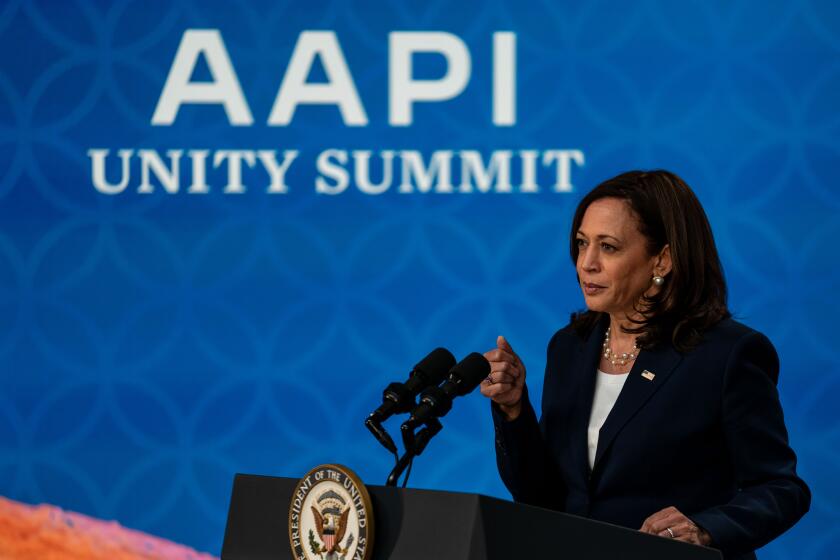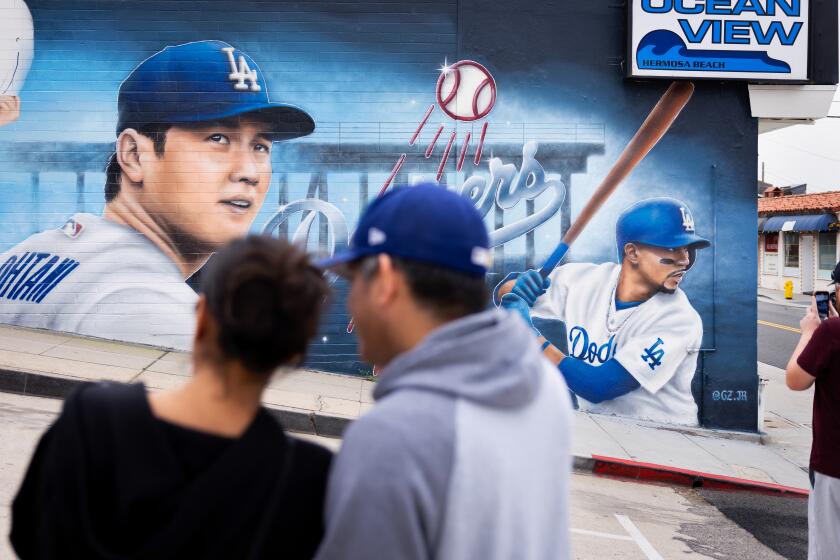Younger Asian Americans navigate something new to their generation: Taking up space

- Share via
NEW YORK — Client after client comes through the 12 Pell barbershop in Manhattan’s Chinatown. They come for the cuts — and for the cool.
On 12 Pell’s lively social media accounts, the young, predominantly Asian American barbers don’t hesitate to offer advice to teens and men of all ages and ethnicities with humor, quips and confidence.
Karho Leung, 34, a son of Chinatown and a 12 Pell co-founder, wanted to start a business that reflected him and his desire for “building the world that I want to live in … not asking for permission.”
About as American as it gets, right? The hunger to find your own way, make your voice heard? A look at social media and pop culture shows Leung and plenty of other Asian Americans of his and younger generations doing just that.
But that American reality hasn’t always belonged to everyone, including previous generations of Asian Americans. That American notion of having the freedom to stake out your own space? Sometimes, oftentimes, that has meant less space for others.
For decades, South Koreans came to the U.S. for a better life. Now many of them are returning, but some say they are encountering a ‘forever foreigner mentality’
Earlier generations of Asian Americans, some of whom have been here for well over a century and others whose roots trace to recent decades, have lived in Americas where their immigrant-origin communities were smaller and regarded as foreign, and where there was little mainstream familiarity with the countries they traced their ancestries to. And there was no Internet or social media culture that encouraged people to define their own lives.
Instead, there were stereotypes that persist to this day — of otherness, of broken-English speaking and passiveness, at times sneaky or suspicious, or nerds and geeks.
But even as those stereotypes still do harm, they don’t have the same power in a time when many Americans eat from a global plate; where yoga studios and henna tattoos, temples and cultural festivals are everywhere, and the size, variety and geography of Asian American communities have increased dramatically in recent decades even as they remain a small part of the overall whole.
Those stereotypes don’t touch Leung the same way they impacted generations before him.
“It’s funny because even though I watched this type of stereotype and portrayal happen growing up, it never really resonated or hit me that that was what I was up against,” he says.
The GOP has historically made inroads with this group. A Trump-Harris match-up would offer a big test.
Jeff Yang, 56, a writer who has spent decades chronicling Asian American communities and culture, laughs when asked whether the cultural space that Leung inhabits and makes his own sounds like the world of Yang’s childhood.
“I grew up in a world where I felt like everything about me was projected on me by other people,” Yang says. “The stories that were being told were all told by non-Asians about what I could do, who I could be, what I could look like.”
It’s not as if that world doesn’t still exist. Simran Anand, 27, was still part of just one of three South Asian families in Reading, Pa., in the 2000s. She can relate, she says, to the sense earlier generations had of feeling culturally isolated in her day-to-day life when she stepped out of the family home.
But she had something they lacked — large-scale South Asian communities in nearby places to visit and interact with.
For her, it’s both/and, not either/or, a sensibility she takes to her jewelry company, BySimran, which drew inspiration from South Asian designs but also adapted to fit her sensibilities as a young American woman.
“I am American, but I’m also South Asian,” she says. “And I don’t have to be one or the other.”
Shohei Ohtani, the two-way Japanese baseball superstar and now Dodgers ace, gives them pride over representation at the highest level in a field relatively few of them tread.
Demetri Manabat, 23, agrees. Born and raised in Las Vegas to a Filipino father and Mexican mother, the spoken word artist says that “it sounds like a different world” to hear about his parents’ experiences growing up.
His parents didn’t teach him or his brothers Tagalog, one of the languages of the Philippines, or Spanish because “they grew up in a time where that was kind of frowned upon to be speaking a different language. And so they were under the assumption that that kind of perception would continue throughout my years, which it didn’t,” Manabat says.
Alex Paik remembers what it was like. The 43-year-old Korean American artist grew up in a predominantly white suburb outside of Philadelphia. “When I was growing up, it was like I either was not Korean enough or too Korean,” he says.
Today, he’s intrigued watching his 11-year-old daughter. “She loves to read, and there’s so many stories now that are written by Asian American women that center Asian and Asian American girls as protagonists,” he says. “I don’t know how it would affect your sense of self, but it must affect it somehow, so I’m really curious to see how she grows up. … It’s just normal for her.”
Though hardly a household name to the general public, Helen Zia is a trailblazer — to some, a legend — in the fight for Asian American civil rights.
Factors that have made a difference in the lives of Asian Americans over time include the baseline demographic reality that there are more, and bigger, communities across the country largely due to the 1965 reform of immigration laws. Globalization has played a hand as well, introducing cultures to each other as the world has gotten smaller. And of course, the internet and technology.
Paik thinks some of what he’s seeing now is also the natural outpouring that comes from a connection to the country that looks different to those born here than it does for those who have immigrated here.
“When you start with the assumption that you belong in a space, I feel like that changes how you approach things,” he says. “Whether or not that space actually wants you is kind of beside the point. There’s an attitude you carry, like, yeah, of course this is my house, this is my country. I grew up here.”
And “I grew up here” — is the operative engine as new generations of Asian Americans rise and claim their own space — even if the assumptions they make about what’s possible for them could be a bit unsettling for other generations.
“Previous generations, of course, they’re going to have that kind of like ‘what is going on’ moment,” Manabat says. “I do think that is the goal, to kind of have that moment of ‘This is insane,’ but it’s everything that you kind of hoped would happen.”
In short: building the world they want to live in. And not asking for permission.
Hajela writes for the Associated Press.
More to Read
Sign up for Essential California
The most important California stories and recommendations in your inbox every morning.
You may occasionally receive promotional content from the Los Angeles Times.














